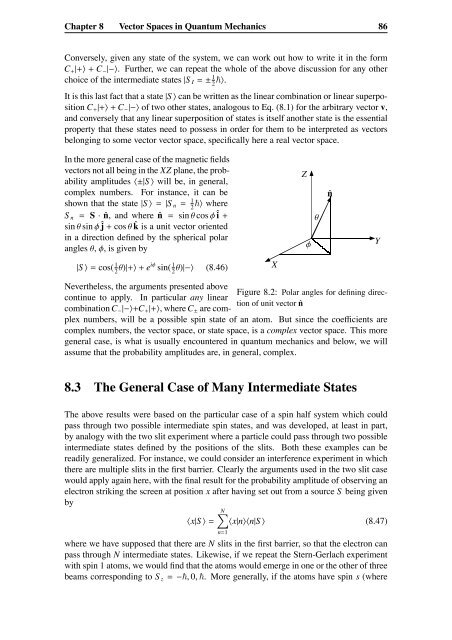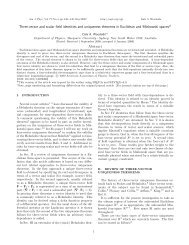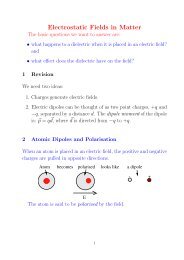Chapter 8 Vector Spaces in Quantum Mechanics
Chapter 8 Vector Spaces in Quantum Mechanics
Chapter 8 Vector Spaces in Quantum Mechanics
You also want an ePaper? Increase the reach of your titles
YUMPU automatically turns print PDFs into web optimized ePapers that Google loves.
<strong>Chapter</strong> 8 <strong>Vector</strong> <strong>Spaces</strong> <strong>in</strong> <strong>Quantum</strong> <strong>Mechanics</strong> 86Conversely, given any state of the system, we can work out how to write it <strong>in</strong> the formC + |+〉 + C − |−〉. Further, we can repeat the whole of the above discussion for any otherchoice of the <strong>in</strong>termediate states |S I = ± 1 2 〉.It is this last fact that a state |S 〉 can be written as the l<strong>in</strong>ear comb<strong>in</strong>ation or l<strong>in</strong>ear superpositionC + |+〉 + C − |−〉 of two other states, analogous to Eq. (8.1) for the arbitrary vector v,and conversely that any l<strong>in</strong>ear superposition of states is itself another state is the essentialproperty that these states need to possess <strong>in</strong> order for them to be <strong>in</strong>terpreted as vectorsbelong<strong>in</strong>g to some vector vector space, specifically here a real vector space.In the more general case of the magnetic fieldsvectors not all be<strong>in</strong>g <strong>in</strong> the XZ plane, the probabilityamplitudes 〈±|S 〉 will be, <strong>in</strong> general,complex numbers. For <strong>in</strong>stance, it can beshown that the state |S 〉 = |S n = 1 〉 where2S n = S · ˆn, and where ˆn = s<strong>in</strong> θ cos φ î +s<strong>in</strong> θ s<strong>in</strong> φ ĵ + cos θ ˆk is a unit vector oriented<strong>in</strong> a direction def<strong>in</strong>ed by the spherical polarangles θ, φ, is given byZφθˆnY|S 〉 = cos( 1θ)|+〉 + 2 eiφ s<strong>in</strong>( 1 θ)|−〉 (8.46)2XNevertheless, the arguments presented aboveFigure 8.2: Polar angles for def<strong>in</strong><strong>in</strong>g directionof unit vector ˆncont<strong>in</strong>ue to apply. In particular any l<strong>in</strong>earcomb<strong>in</strong>ation C − |−〉+C + |+〉, where C ± are complexnumbers, will be a possible sp<strong>in</strong> state of an atom. But s<strong>in</strong>ce the coefficients arecomplex numbers, the vector space, or state space, is a complex vector space. This moregeneral case, is what is usually encountered <strong>in</strong> quantum mechanics and below, we willassume that the probability amplitudes are, <strong>in</strong> general, complex.8.3 The General Case of Many Intermediate StatesThe above results were based on the particular case of a sp<strong>in</strong> half system which couldpass through two possible <strong>in</strong>termediate sp<strong>in</strong> states, and was developed, at least <strong>in</strong> part,by analogy with the two slit experiment where a particle could pass through two possible<strong>in</strong>termediate states def<strong>in</strong>ed by the positions of the slits. Both these examples can bereadily generalized. For <strong>in</strong>stance, we could consider an <strong>in</strong>terference experiment <strong>in</strong> whichthere are multiple slits <strong>in</strong> the first barrier. Clearly the arguments used <strong>in</strong> the two slit casewould apply aga<strong>in</strong> here, with the f<strong>in</strong>al result for the probability amplitude of observ<strong>in</strong>g anelectron strik<strong>in</strong>g the screen at position x after hav<strong>in</strong>g set out from a source S be<strong>in</strong>g givenbyN∑〈x|S 〉 = 〈x|n〉〈n|S 〉 (8.47)n=1where we have supposed that there are N slits <strong>in</strong> the first barrier, so that the electron canpass through N <strong>in</strong>termediate states. Likewise, if we repeat the Stern-Gerlach experimentwith sp<strong>in</strong> 1 atoms, we would f<strong>in</strong>d that the atoms would emerge <strong>in</strong> one or the other of threebeams correspond<strong>in</strong>g to S z = −, 0, . More generally, if the atoms have sp<strong>in</strong> s (where
















